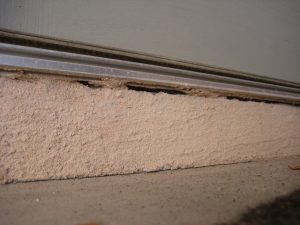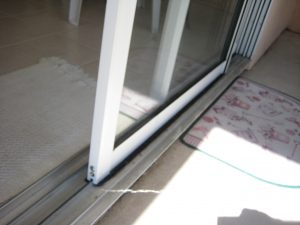It’s been one of my duties for several years to train new employees some of the finer points of the job. I give the flashlight speech and make sure they know where the batteries are kept and how to safely crawl an attic and some take to it rather quickly while others need more time. There is however one sweet spot in every house that at the very least needs to be looked at each and every-time you go. My guess is that many of the insect pests that enter the home come in this way and the technician as well as the homeowner pass right over it every time they enter the home.
What is it you ask? The threshold of course and I can’t tell you how many roaches, earwigs, spiders and scorpions I find in this spot and unfortunately most tech’s pass it over 2 or 3 times per service and never once bend down to take a look. Oh sure they may spray on the top side of the expanse and maybe even bend down just the slightest to quickly wave their B&G wand under the lip for a quick sprits and call it good. Take a look at a threshold the next time you treat an account, a good look and you may be  surprised at what you see. In many that you look at you will find cracks, gaps, screw holes (with no screw) or even that the door bottom and the threshold don’t meet for a nice seal. Now before you assume that a tiny crack or a missing screw can’t pose any problem consider this. Most thresholds, indeed entire door framing is hollow once you get through the protective layer. Most handy men I know hate hanging doors because it never fits perfectly. To compensate they use shims and creative work to make it solid but that usually leaves many great voids that a bug finds with ease. Once inside the voids it’s pretty easy for an unwanted bug to make his appearance on the other side.
surprised at what you see. In many that you look at you will find cracks, gaps, screw holes (with no screw) or even that the door bottom and the threshold don’t meet for a nice seal. Now before you assume that a tiny crack or a missing screw can’t pose any problem consider this. Most thresholds, indeed entire door framing is hollow once you get through the protective layer. Most handy men I know hate hanging doors because it never fits perfectly. To compensate they use shims and creative work to make it solid but that usually leaves many great voids that a bug finds with ease. Once inside the voids it’s pretty easy for an unwanted bug to make his appearance on the other side.
There are many different kinds of thresholds and each one presents a different challenge. Garage thresholds are difficult because many times a built in expansion joint makes a super highway off ramp right inside for a bug. Sliders are tough because the metal doesn’t allow for liquids to set up and stick to an area that a bug might come in contact. The popular front door aluminum pre-made thresholds come with a built in void which offers protection and passage. Bricks, wood and cement also have entry ways that pests use but are not always so easily seen.
 My advice to treat these areas is to first examine them thoroughly which means getting on your hands and knees to see exactly what the bug sees. Open gaps can most often be caulked or loose boards can be secured or door seal guards may do the trick. I would suggest before any sealing however to treat the void most preferably with a dust material. Insecticidal dust will last a longer time than say a liquid or shot of Raid. For entry points you cannot seal (most often found in sliders) you may need to spray as best you can on both sides and perhaps sprinkle some light granules on the tracks where the door rides the slides. It’s just a thought-you need to take into account the specific situation like is there a puppy around who licks everything. If nothing else you can at least identify areas where the activity may be coming in and treat that area with a little more care. I find that having different dusters comes in handy for this application. The small (mini) bulb or the curved tips can serve you well here as well as a straw tip on a can of Borid (aerosol). If you need you can always mix up a wettable powder such as Tempo so that when the water dries up, the dust is left inside the crack just as if you puffed it in there dry.
My advice to treat these areas is to first examine them thoroughly which means getting on your hands and knees to see exactly what the bug sees. Open gaps can most often be caulked or loose boards can be secured or door seal guards may do the trick. I would suggest before any sealing however to treat the void most preferably with a dust material. Insecticidal dust will last a longer time than say a liquid or shot of Raid. For entry points you cannot seal (most often found in sliders) you may need to spray as best you can on both sides and perhaps sprinkle some light granules on the tracks where the door rides the slides. It’s just a thought-you need to take into account the specific situation like is there a puppy around who licks everything. If nothing else you can at least identify areas where the activity may be coming in and treat that area with a little more care. I find that having different dusters comes in handy for this application. The small (mini) bulb or the curved tips can serve you well here as well as a straw tip on a can of Borid (aerosol). If you need you can always mix up a wettable powder such as Tempo so that when the water dries up, the dust is left inside the crack just as if you puffed it in there dry.
Well those are just a coupletips on stopping the infestation that’s always right there at the doorway, waiting to come in. If you’ve got some tips, we’d love to hear them. They don’t need to be rocket science, just anything that can help us all in our quest to provide pest free living for our customers or perhaps something that helps keep us all safe. Send me an
some tips, we’d love to hear them. They don’t need to be rocket science, just anything that can help us all in our quest to provide pest free living for our customers or perhaps something that helps keep us all safe. Send me an
e-mail or go through the Ask The Bug Doctor page which will also allow you to send a picture if you have one.




